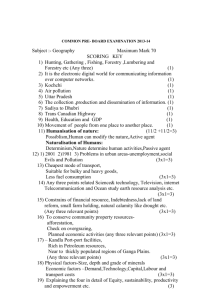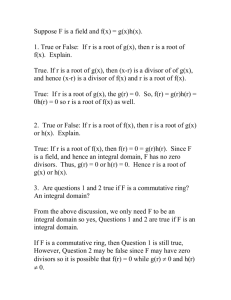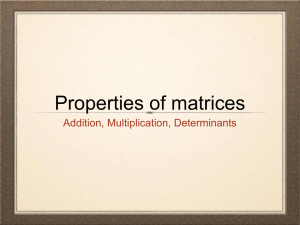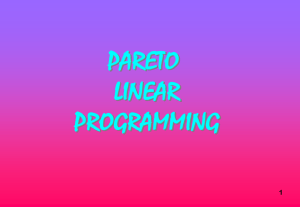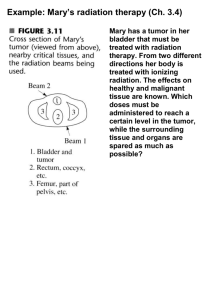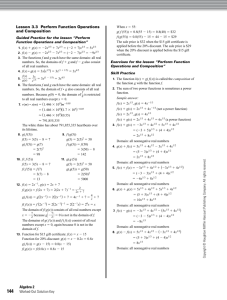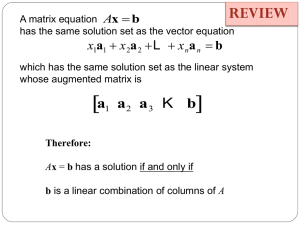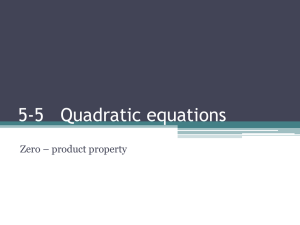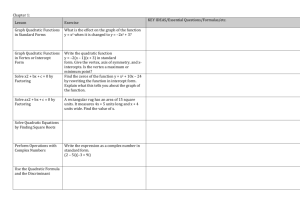HW8 Solutions
advertisement
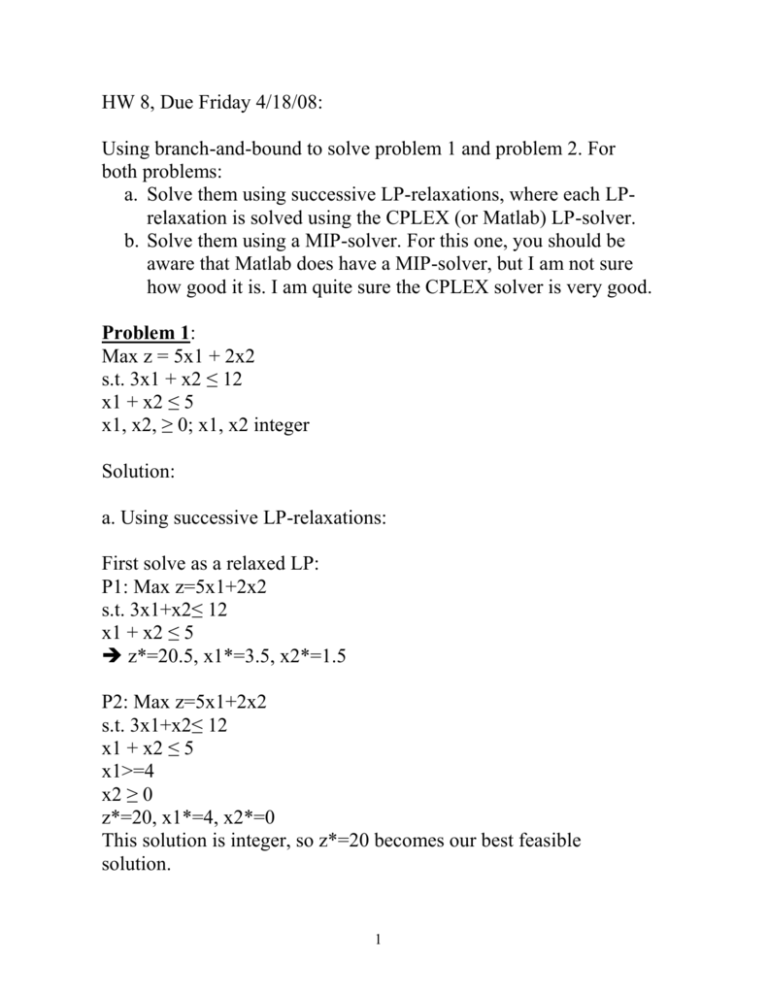
HW 8, Due Friday 4/18/08: Using branch-and-bound to solve problem 1 and problem 2. For both problems: a. Solve them using successive LP-relaxations, where each LPrelaxation is solved using the CPLEX (or Matlab) LP-solver. b. Solve them using a MIP-solver. For this one, you should be aware that Matlab does have a MIP-solver, but I am not sure how good it is. I am quite sure the CPLEX solver is very good. Problem 1: Max z = 5x1 + 2x2 s.t. 3x1 + x2 ≤ 12 x1 + x2 ≤ 5 x1, x2, ≥ 0; x1, x2 integer Solution: a. Using successive LP-relaxations: First solve as a relaxed LP: P1: Max z=5x1+2x2 s.t. 3x1+x2≤ 12 x1 + x2 ≤ 5 z*=20.5, x1*=3.5, x2*=1.5 P2: Max z=5x1+2x2 s.t. 3x1+x2≤ 12 x1 + x2 ≤ 5 x1>=4 x2 ≥ 0 z*=20, x1*=4, x2*=0 This solution is integer, so z*=20 becomes our best feasible solution. 1 P3: Max z=5x1+2x2 s.t. 3x1+x2≤ 12 x1 + x2 ≤ 5 x1<=3 x2 ≥ 0 z*=19, x1*=3, x2*=2 The objective function value is not as good as that of our best feasible solution and therefore we may stop pursuing this branch. Let’s go back and force x2 to be integer. P4: Max z = 5x1 + 2x2 s.t. 3x1 + x2 ≤ 12 x1 + x2 ≤ 5 x2 ≥ 2 x1 ≥ 0 x1, x2, ≥ 0 z*=19, x1*=3, x2*=2 The objective function value is not as good as that of our best feasible solution and therefore we may stop pursuing this branch. P5: Max z = 5x1 + 2x2 s.t. 3x1 + x2 ≤ 12 x1 + x2 ≤ 5 x2 ≤ 1 x1 ≥ 0 x1, x2, ≥ 0 z*=20.3, x1*=3.667, x2*=1 The objective function value is better than that of our best feasible solution, but this solution is not integer. Therefore we need to continue pursuing this branch. Let’s force x1=3. 2 P6: Max z = 5x1 + 2x2 s.t. 3x1 + x2 ≤ 12 x1 + x2 ≤ 5 x2 ≤ 1 x1 ≤ 3 x1, x2, ≥ 0; z*=17, x1*=3, x2*=1 The objective function value is not as good as that of our best feasible solution and therefore we may stop pursuing this branch. Let’s force x1=3.: P7: Max z = 5x1 + 2x2 s.t. 3x1 + x2 ≤ 12 x1 + x2 ≤ 5 x2 ≤ 1 x1 ≥ 4 x1, x2, ≥ 0; z*=20, x1*=4, x2*=0 Which is the same solution as that obtained in P2. All possible branches have been considered, therefore the solution to P2 becomes the solution to the problem: z*=20, x1*=4, x2*=0. b. Using MIP solver: z*=20, x1*=4, x2*=0. Problem 2: Max z = 3x1 + x2 s.t. 5x1 + 2x2 ≤ 10 4x1 + x2 ≤ 7 x1, x2,≥ 0; x2 integer 3 a. Using successive LP-relaxations: First solve as a relaxed LP: P1: Max z = 3x1 + x2 s.t. 5x1 + 2x2 ≤ 10 4x1 + x2 ≤ 7 x1, x2,≥ 0; z*=5.667, x1*=1.333, x2*=1.667 Force x1=1. P2: Max z = 3x1 + x2 s.t. 5x1 + 2x2 ≤ 10 4x1 + x2 ≤ 7 x1≤1 x1, x2,≥ 0; z*=5.5, x1*=1, x2*=2.5 Force x2=2. P3: Max z = 3x1 + x2 s.t. 5x1 + 2x2 ≤ 10 4x1 + x2 ≤ 7 x1≤1 x2≤2 x1, x2,≥ 0; z*=5.0, x1*=1, x2*=2 This is a feasible solution (all integer) and therefore z*=5 represents our best bound found so far. Now let’s branch the other way from P2 by forcing x2=3. 4 P4: Max z = 3x1 + x2 s.t. 5x1 + 2x2 ≤ 10 4x1 + x2 ≤ 7 x1≤1 x2≥3 x1, x2,≥ 0; z*=5.4, x1*=0.8, x2*=3 P4 is not feasible but it has a better bound than our best bound so far (of 5.0). So we need to branch further on P4. Force x1 to 1. P5: Max z = 3x1 + x2 s.t. 5x1 + 2x2 ≤ 10 4x1 + x2 ≤ 7 x1≥1 x2≥3 x1, x2,≥ 0; This one is infeasible. Go the other way by forcing x1 to 0. P6: Max z = 3x1 + x2 s.t. 5x1 + 2x2 ≤ 10 4x1 + x2 ≤ 7 x1≤0 x2≥3 x1, x2,≥ 0; z*=5.0, x1*=0, x2*=5 This is a feasible solution and it has objective function value equal to our best bound so far (P3). So now go back to P1 and branch the other way by forcing x1=2. 5 P7: Max z = 3x1 + x2 s.t. 5x1 + 2x2 ≤ 10 4x1 + x2 ≤ 7 x1≥2 x1, x2,≥ 0; This problem is infeasible, and so we are done. There are two answers: From P3: z*=5.0, x1*=1, x2*=2 From P6: z*=5.0, x1*=0, x2*=5 b. Using MIP solver: z*=5, x1*=0, x2*=5. 6

